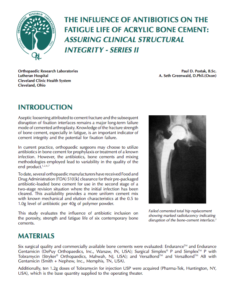 Aseptic loosening attributed to cement fracture and the subsequent disruption of fixation interfaces remains a major long-term failure mode of cemented arthroplasty. Knowledge of the fracture strength of bone cement, especially in fatigue, is an important indicator of cement integrity and the potential for fixation failure. In current practice, orthopaedic surgeons may choose to utilize antibiotics in bone cement for prophylaxis or treatment of a known infection. However, the antibiotics, bone cements and mixing methodologies employed lead to variability in the quality of the end product. To date, several orthopaedic manufacturers have received Food and Drug Administration (FDA) 510[k] clearance for their pre-packaged antibiotic-loaded bone cement for use in the second stage of a two-stage revision situation where the initial infection has been cleared. This availability provides a more uniform cement mix with known mechanical and elution characteristics at the 0.5 to 1.0g level of antibiotic per 40g of polymer powder. This study evaluates the influence of antibiotic inclusion on the porosity, strength and fatigue life of six contemporary bone cements.
Aseptic loosening attributed to cement fracture and the subsequent disruption of fixation interfaces remains a major long-term failure mode of cemented arthroplasty. Knowledge of the fracture strength of bone cement, especially in fatigue, is an important indicator of cement integrity and the potential for fixation failure. In current practice, orthopaedic surgeons may choose to utilize antibiotics in bone cement for prophylaxis or treatment of a known infection. However, the antibiotics, bone cements and mixing methodologies employed lead to variability in the quality of the end product. To date, several orthopaedic manufacturers have received Food and Drug Administration (FDA) 510[k] clearance for their pre-packaged antibiotic-loaded bone cement for use in the second stage of a two-stage revision situation where the initial infection has been cleared. This availability provides a more uniform cement mix with known mechanical and elution characteristics at the 0.5 to 1.0g level of antibiotic per 40g of polymer powder. This study evaluates the influence of antibiotic inclusion on the porosity, strength and fatigue life of six contemporary bone cements.
The Influence of Antibiotics on the Fatigue Life of Acrylic Bone Cement: Assuring Clinical Structural Integrity – Series II
Mar 7, 2005 | General

